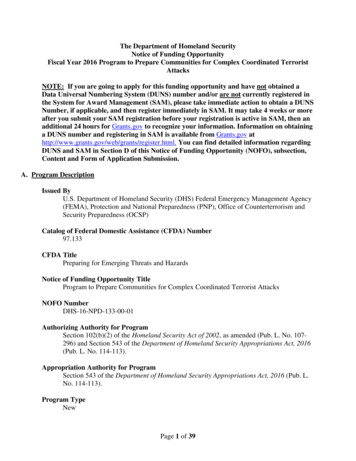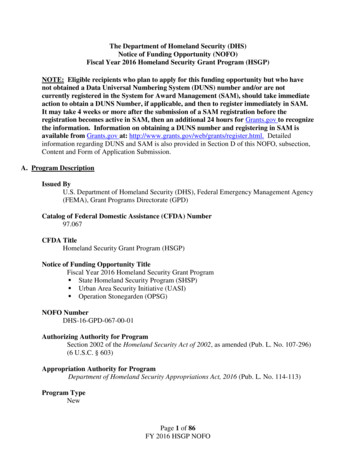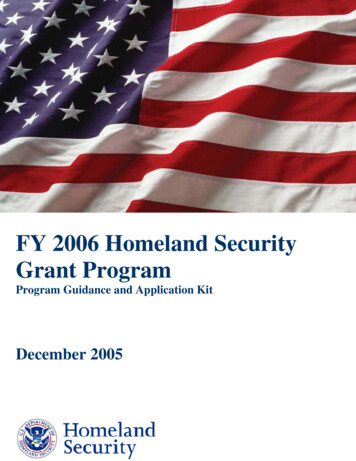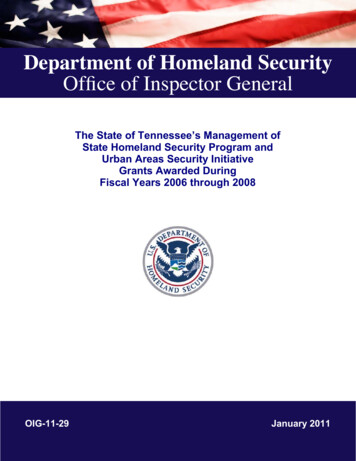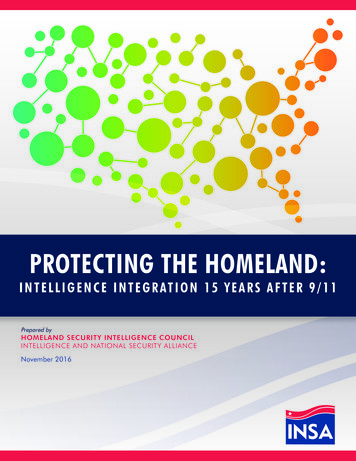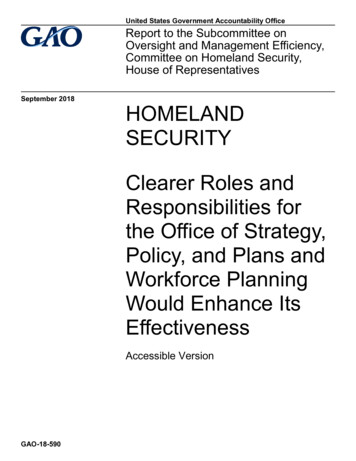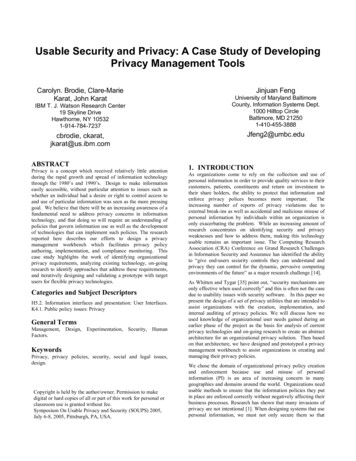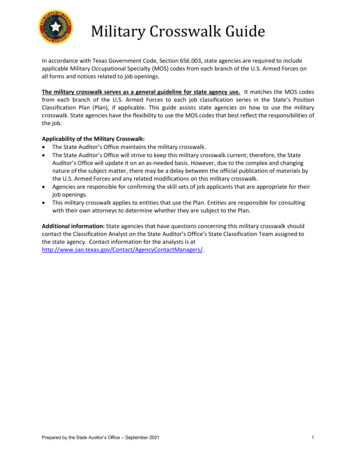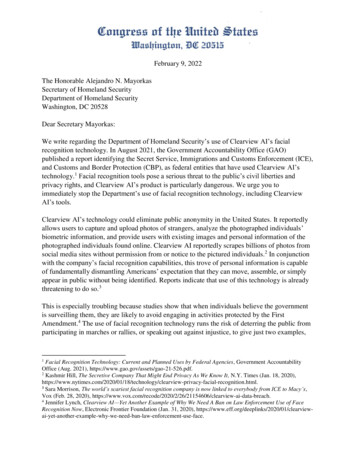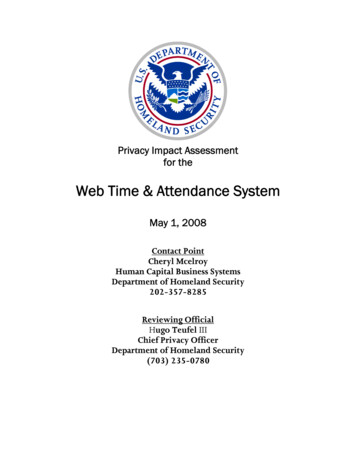
Transcription
Privacy Impact Assessmentfor theWeb Time & Attendance SystemMay 1, 2008Contact PointCheryl McelroyHuman Capital Business SystemsDepartment of Homeland Security202-357-8285Reviewing OfficialHugo Teufel IIIChief Privacy OfficerDepartment of Homeland Security(703) 235-0780
Privacy Impact AssessmentOffice of the Chief Human Capital Officer, Web T & APage 2AbstractThe Department of Homeland Security (DHS) Office of the Chief Human Capital Officer (OCHO)has procured a COTS application and customized it to meet DHS standard requirements. This system isdesigned to implement an enterprise system that can efficiently automate the timesheet collection processand provide robust reporting features and a labor distribution capability. This privacy impact assessmentwas conducted because WebTA utilizes personally identifiable information.IntroductionThe Human Resources Information Technology Program is a collection of functions and systemscentered on a core enterprise Human Resource Management System (HRMS). The Program is part of abroader “OneDHS “ model where collection of disparate and redundant systems across DHS is consolidatedinto enterprise wide solutions.An enterprise WebTA system is a key component of HRMS. The goal of the WebTA system is toreduce the number of existing WebTA systems within DHS and consolidate the requirements into oneenterprise system. In the initial phase of the WebTA deployment, the system will focus on capturing andreporting employee time and attendance data. In the broader HRIT program, there will be a core HRsystem that organizational components will access for all HR functions. The WebTA system will interfacewith this core system as well as the United States Department of Agriculture’s (USDA) National FinanceCenter (NFC), DHS’ payroll provider.During the time and attendance week, WebTA is setup toautomatically send all timecards to NFC for processing. This procedure occurs several times a day duringattendance week. The WebTA system expedites the processing of data associated with Time andAttendance, payroll/personnel processing. This information could include billing from amendedtimecards.The system adheres to the Inter-Agency Agreement, which is designed to ensure theconfidentiality, integrity, and availability of data for both partiesTypical TransactionAn employee or timekeeper enters the employee’s information, hours worked, and any leave used(among other possible data) into the WebTA system. This can be done daily or any time during the payperiod. When the pay period has ended, a timekeeper or employee will confirm their data entry byclicking the “Validate” button. Once the timecard passes the edit phase, the supervisor verifies the accuracyof the data and certifies the information. Once the timecard is certified, the data is transmitted to thepayroll system and is again validated for accuracy. 1 Once the timecard has passed the edits, it is placed onthe database so the employee’s pay can be calculated.The WebTA system will modernize time collection within DHS as employee time and attendancedata will be entered interactively by DHS personnel. The program will enable DHS to implement anThis second editing phase is due to not all front-end system currently being used by the components havethe extensive edits built in.1
Privacy Impact AssessmentOffice of the Chief Human Capital Officer, Web T & APage 3enterprise system that can efficiently automate the timesheet collection process and provide robustreporting features and a labor distribution capability.Section 1.0 Information Collected and Maintained1.1What information is to be collected?Employee data: social security number (SSN), last name, first name, middle name, alternate workschedule (AWS), pay plan, tour of duty, duty hours, scd for leave,Timesheet data, accounting codes, time off, annual leave, sick leave, comp time, leave without pay(LWOP), absence without leave (AWOL), military emergency, military regular, unapproved annual leave,and all types of premium pay.NOTE: It is the intent of Human Capital Business Systems (HCBS) to migrate away from using SSNsin the Time & Attendance system once all DHS employees are assigned employee identification numbers.Currently, all of the agencies that have been deployed to webTA are using SSNs as employee IDs; therefore,HCBS must continue to use the SSN as the unique identifier in the application. USCG, TSA, FAMS, HQ,USSS, FLETC, FEMA and ICE have all been deployed. All other components do not have a timeframe fordeployment as yet.1.2From whom is information collected?When an employee begins working at DHS, the employee profile and T&A profile are establishedby the timekeeper of the employee. The WebTA application allows the employee or the timekeeper toenter time and attendance data in the system for each pay period.1.3Why is the information being collected?The WebTA system collects this information in order to record employee hours worked, andmonitor attendance and employee holiday/vacation and determine leave balances. The WebTA system willenhance the current payroll processing function by improving the employee timesheet submission processwhich includes work hours and other types of employee time such as leave and other absences.1.4How is the information collected?The additional rolling out of data entry to the individual employee is up to each componenttherefore timeframes are constantly changing. The timesheet data entered for employees is transmitted via asecure communications link to the National Finance Center which hosts the WebTA application and is alsothe payroll service provider for DHS. After timesheet data is submitted to NFC, DHS employees or theirtimekeepers may make corrections to employee records if it is determined that an individual’s reportedhours or accounting codes were incorrect. The method of data entry is determined by each individualcomponent.
Privacy Impact AssessmentOffice of the Chief Human Capital Officer, Web T & APage 41.5What specific legal authorities/arrangements/agreements definethe collection of information?The Homeland Security Act of 2002 called for the establishment of a new human resources systemfor the DHS that is flexible and contemporary. In related legislation, the E-Government Act of 2002 calledfor the use by the Government of web-based Internet applications and other information technologies,combined with processes that implement these technologies, to bring about improvements in Governmentoperations that may include effectiveness, efficiency, service quality, or transformation. It also called forthe adoption of innovative information technology, including the appropriate use of commercial bestpractices. Authority for Maintenance of the System: 5 U.S.C. 1302, 3109, 3301, 3302, 3304, 3305, 3306,3307, 309, 3313, 3317, 3318, 3319, 3326, 4103, 4723, 5532, and 5533, and Executive Order 9397.1.6Privacy Impact Analysis: Given the amount and type of data beingcollected, discuss what privacy risks were identified and how theywere mitigated.Recognizing that employee’s Social Security Numbers (SSNs) are of particular sensitivity, WebTA isworking to phase out the use of the SSN as a personal identifier. Once the remaining DHS componentshave been completely converted to WebTA identifier instead of the SSN as an identifier, the risk of use ofthe SSN will be eliminated. This PIA will be updated once SSN has been phased out of DHS operations.Section 2.0 Uses of the System and the Information2.1Describe all the uses of information.The time and attendance data will be compiled for use in processing payroll through the NFC basedon hours worked and leave taken. In addition to payroll efforts, the information will be used to accuratelyrecord work hours, and monitor attendance and employee holiday/vacation and determine leave balances.2.2Does the system analyze data to assist users in identifyingpreviously unknown areas of note, concern, or pattern (Sometimesreferred to as data mining)?The capability exists to capture project codes, project name, and locator information in WebTA thatsupports labor distribution accounting which is not available in the NFC system of record. However, thisdata is voluntary. Additionally, DHS wide reports are not possible at this time because all components arenot using the system. Usage of the WebTA system is not mandatory.2.3 How will the information collected from individuals or derived fromthe system be checked for accuracy?Edit checks are built into the system. Timesheets will also be reviewed by supervisors to furtherensure accuracy. NFC will run the data through their T&A Validation Edit and Messaging, which willproduce error reports. If the component has enabled data entry to employees, they can make changes to
Privacy Impact AssessmentOffice of the Chief Human Capital Officer, Web T & APage 5the historical timesheet. The corrected timesheet will have to be validated by the employee and certified bythe supervisor. At that time, the timecard is locked in preparation of transmission to the Payroll system.Additionally they can update other items such as their default schedule, leave and premium pay requests,etc. If the component has enabled entry to the employees, generally they do not provide the employeewith the user ID and password to access the system.2.4Privacy Impact Analysis: Given the amount and type of informationcollected, describe any types of controls that may be in place toensure that information is used in accordance with the abovedescribed uses.The scope of the information collection (detailed above) is narrowly tailored to ensure that theinformation collected matches the uses. Information collected will not be used for any other purpose. Thereporting and analytical tools help the Department better refine HR practices. The accuracy of theinformation is ensured by both employee input and supervisor verification.Section 3.0 Retention3.1What is the retention period for the data in the system?Data will be retained on-line for six years in accordance with the NARA General Records Schedulewhich stipulates that, for Time and Attendance Input Records “records in either paper or machine readableform used to input time and attendance data into a payroll system, maintained either by agency or payrollprocessor” can be destroyed after a General Accountability Office (GAO) audit or when 6 years old,whichever is sooner. Active employee records require on-line access for the duration of employment.3.2Has the retention schedule been approved by the NationalArchives and Records Administration (NARA)?NARA will evaluate records in system by 2007 after DHS completes its scheduling. All records areconsidered permanent until full evaluation is complete.3.3Privacy Impact Analysis: Given the purpose of retaining theinformation, explain why the information is needed for theindicated period.The information is retained for a time that is reasonable considering government reportingfunctions and auditing while respecting an individual’s right to have their information deleted once it is nolonger needed for the purpose for which it was collected. Any shorter period would compromise theDepartment’s reporting and auditing requirements, while a longer period would be a potential harm to theindividual by unnecessarily retaining their information.
Privacy Impact AssessmentOffice of the Chief Human Capital Officer, Web T & APage 6Section 4.0 Internal Sharing and Disclosure4.1With which internal organizations is the information shared?The USCG, TSA, FAMS, HQ, USSS, FLETC, FEMA and ICE are using the WebTA application to inputtime attendance. The data for each component is only accessible by the individual component. .4.2For each organization, what information is shared and for whatpurpose?Information contained in WebTA is not shared with other components except in the case ofemployee transfer from one component to another. Even with this, the limitation of what is seen is limitedto uses associated with human resources functions.4.3How is the information transmitted or disclosed?There is a single system which the above-noted components use to enter WebTA data. The systemcommunications are handled in the highly secure environment contained within NFC’s infrastructurewhich has a current Certification and Accreditation (C&A). The information is not shared with otheragencies except in the case of employee transfer. Other DHS components can only view their respectivedata.4.4Privacy Impact Analysis: Given the internal sharing, discuss whatprivacy risks were identified and how they were mitigated.The risks associated with internal sharing are minimal because WebTA does not share informationwith any component other than the component which provided information.Section 5.0 External Sharing and Disclosure5.1With which external organizations is the information shared?The WebTA system shares information with the USDA’s NFC (bi weekly payroll data).5.2What information is shared and for what purpose?The system will only share time and attendance and payroll processing data. The following fieldsare shared:Name (First, middle, and last name)SSNPay PlanDuty of hours
Privacy Impact AssessmentOffice of the Chief Human Capital Officer, Web T & APage 7Tour of DutyService Computation dateAgency codeAccounting CodeTransaction CodesThis allows WebTA and the NFC to operate on the same set of information in order to payemployees and account for leave. The information shared is to expedite the processing of data associatedwith time and attendance, payroll/personnel processing. This information could include billing fromamended timecards. The system is designed to provide labor distribution data to assist with financialmanagement activities in DHS; TSA is the only component that is using project based accounting at thistime.5.3How is the information transmitted or disclosed?The timesheet data entered for employees is transmitted via a secure communications link to theNational Finance Center which hosts the WebTA application and is also the payroll service provider forDHS. After timesheet data is submitted to NFC, DHS personnel may make corrections to employee recordsif it is determined that an individual’s reported hours or accounting codes were incorrect.5.4Is a Memorandum of Understanding (MOU), contract, or anyagreement in place with any external organizations with whominformation is shared, and does the agreement reflect the scope ofthe information currently shared?Yes. The Department and USDA are partners to an Interconnection Service Agreement.5.5How is the shared information secured by the recipient?NFC, which services many other federal agencies, has undergone a C&A. The InterconnectionService Agreement is designed to ensure the confidentiality, integrity, and availability of data for bothparties. The agreement covers data sensitivity, information exchange security, trusted behavior, incidentreporting, audit trail responsibilities, security parameters, and security awareness and training. The securityof the information being passed on the two-way connection is protected through the use of 128bit SSL thatis then passed through firewalls and VPN connection points to the receiving data. Anti-virus and intrusiondetection systems are deployed for the Department. The connections at each end are located withcontrolled access facilities. Individual users will not have access to the data except through their systemssecurity software inherent to the operating system. All access is controlled by identification andauthentication methods to validate approved users.5.6What type of training is required for users from agencies outsideDHS prior to receiving access to the information?Each DHS component and the NFC are required to administer security and privacy training.
Privacy Impact AssessmentOffice of the Chief Human Capital Officer, Web T & APage 85.7Privacy Impact Analysis: Given the external sharing, what privacyrisks were identified and describe how they were mitigated.Although there are risks inherent with any external sharing such risks have been mitigated to thefullest extent possible in WebTA’s sharing with the NFC. DHS and USDA operate under an ISA whichdetails the sharing of information between Departments. Each system has completed a C & A package andeach system transmits information in a secure manner. Inasmuch as risks cannot be completely nullified,all risks associated with external sharing are reasonably mitigated.Section 6.0 Notice6.1Was notice provided to the individual prior to collection ofinformation? If yes, please provide a copy of the notice as anappendix. A notice may include a posted privacy policy, a PrivacyAct notice on forms, or a system of records notice published in theFederal Register Notice. If notice was not provided, why not?Notice of the system and the system’s operation is provided in two ways.First, WebTA is covered by the Office of Personnel Management government-wide system ofrecords notice (SORN) OPM-GOVT1, General Personnel Records (June 19, 2006, 71 FR 35356). DHS is inthe process of developing a DHS-specific system of records notice to cover DHS time and attendancesystems, but until that time OPM-GOVT1 appropriately notifies individuals of the collection of generalpersonnel data, including time sheets.Second, when logging into WebTA users are notified that they are accessing a government systemand that any information submitted or retrieved on the system is subject to monitoring and recording byDHS system security officers.6.2Do individuals have an opportunity and/or right to decline toprovide information?Employee timesheet submission is required by policy and is a condition of employment.Compensation is determined by timesheet data.6.3Do individuals have the right to consent to particular uses of theinformation, and if so, how does the individual exercise the right?Accounting for employee hours is part of the terms of employment. Employees can discussconcerns with their supervisors who will address them accordingly. The use of employee information islimited to what is required for proper time and attendance, leave, and payroll calculation (see Section 2.0and 5.0).
Privacy Impact AssessmentOffice of the Chief Human Capital Officer, Web T & APage 96.4Privacy Impact Analysis: Given the notice provided to individualsabove, describe what privacy risks were identified and how youmitigated them.The notice provided regarding the existence and operation of the system is adequate for the needsof government employees who are, by virtue of employment, under notice that all actions undertaken forpersonnel purposes is recorded and logged. Once the DHS-specific SORN is drafted, this notice will berefined for the DHS employee audience.Section 7.0 Individual Access, Redress and Correction7.1What are the procedures which allow individuals to gain access totheir own information?Timekeepers can verify and amend employee information as necessary directly through the system.Employees are, capable of entering their own time, changing their default schedule and processingamended timecards, if necessary.7.2What are the procedures for correcting erroneous information?Edit checks are built into the system and allow employees to make changes interactively, howeveremployee entered corrections have a limited processing cycle within that pay period or they will have towait until the following pay period for submission. Timekeepers will also be able to correct erroneousinformation or submit correct timecards. Corrections in this system will be consistent with NFC processes.Historical updates are limited to specific user roles7.3How are individuals notified of the procedures for correcting theirinformation?In WebTA, timekeepers, as well as, employees are authorized to make corrections. The proceduresfor making corrections are in the User’s Guide and the training material. This information follows federalregulations and NFC’s directives regarding processing corrections. If an employee requires a correction tohis/her timecard, they must either contact their timekeeper or if participating in employee based time entrythey can enter a correction themselves. The corrected timecard must be certified by their supervisor.Employees are allowed to correct historical records and not missing records, and the correctedtimesheet will have to be validated by the employee or timekeeper and then certified by their supervisor.DHS approval of changes ensures information accuracy integrity.7.4If no redress is provided, are alternatives are available?Redress is provided by direct amending of records by supervisors and employees.
Privacy Impact AssessmentOffice of the Chief Human Capital Officer, Web T & APage 107.5Privacy Impact Analysis: Given the access and other proceduralrights provided for in the Privacy Act of 1974, explain theprocedural rights that are provided and, if access, correction andredress rights are not provided please explain why not.WebTA is premised on the idea of the importance of accurate employee information. BecauseWebTA controls accurate timekeeping and, in its relationship with the NFC, employee paychecks, robustinformation correction measures are in place. Not only do WebTA and NFC synchronize every two weeksbut timesheet information is verified at least twice before being submitted to NFC. The multiple levels ofinput into the employee’s information ensure accurate information as well as employee involvement intheir record and timekeeping. Procedural mechanisms for access and correction are included within theapplication. The application tracks all corrections through a history table, which displays who and whatchanges were made to an employee time record.Section 8.0 Technical Access and Security8.1Which user group(s) will have access to the system? (For example,program managers, IT specialists, and analysts will have generalaccess to the system and registered users from the public willhave limited access.)The WebTA system will allow users, supervisors, timekeepers, approvers, and/or administrators toretrieve employee information based on their Login Name, subject to role-based data access controls. Theconvention for the Login Name uses a combination of the user’s last name, first initial, and the last fourdigits of their social security number in reverse (e.g., DoeJ4321). DHS has determined the roleassignments, and the roles are noted in application and documentation.8.2Will contractors to DHS have access to the system? If so, pleasesubmit a copy of the contract describing their role to the PrivacyOffice with this PIA.The contractor selected to manage the application, will provide system administrators to performadministration tasks to include add/delete users, and administer the application and database.8.3Does the system use “roles” to assign privileges to users of thesystem?Yes, the roles restrict users to what actions or system functions they have access to. There are twolevels of data security within WebTA, the agency code and the organization tree restricts users to the datathey can see.
Privacy Impact AssessmentOffice of the Chief Human Capital Officer, Web T & APage 111. Employee – WebTA is designed as a self service system and every employee record is assigned alogin ID, password and the employee role as the most basic role in WebTA and is restricted toagency and organization. Not all agencies use WebTA as a self service application.2. Timekeeper – The timekeeper role is used to add new employee data, edit, correct and validatetime and attendance data, time and attendance profiles, employee profiles and locator informationfor their assigned employees. This role is restricted by agency and organization.3. Master Timekeeper Restricted – The master timekeeper role is used to add new employee data,edit, correct and validate time and attendance data, time and attendance profiles, employee profilesand locator information. This role is restricted by agency only. If there are several organizationswithin an agency, this role is at the top of the organization tree within a specific agency.4. Master Timekeeper Read only – The master timekeeper role is used to view time and attendancedata, time and attendance profiles, employee profiles and locator information only. This role isrestricted by agency only. If there are several organizations within an agency, this role is at the topof the organization tree within a specific agency.5. HR Administrator – HR Administrators manage the leave transfer program, manage roleassignments, edit and add organizations to the organizational chart, edit and add accounting dataand manage employees within their agency. This role is restricted by agency and can be restrictedby organization.6. Supervisor – The supervisor role can only review and certify time and attendance reports for theirassigned employees. This role is restricted by agency and organization.7. Master Supervisor Restricted – The supervisor role can only review and certify time andattendance reports for any employee within an agency. If there are several organizations within anagency, this role is at the top of the organization tree within a specific agency.8. Project Manager – The project manager administers the project hierarchy of the accounting codes.This role is restricted by agency and can be restricted by organization.9. Master Timekeeper – The master timekeeper role is used to add new employee data, edit, correctand validate time and attendance data, time and attendance profiles, employee profiles and locatorinformation globally. This role is not restricted by agency or organization and is kept at the SystemAdministrator level.10. Master Supervisor – The supervisor role can only review and certify time and attendance reportsfor any employee globally. This role is not restricted by agency or organization and is kept at theSystem Administrator level.11. Administrator – Administrators manage the Time and Attendance System. This includes systemconfiguration, build management, and managing employee’s roles and role assignment on a globallevel. This role is not restricted by agency or organization.
Privacy Impact AssessmentOffice of the Chief Human Capital Officer, Web T & APage 128.4What procedures are in place to determine which users mayaccess the system and are they documented?The WebTA servers primarily use traditional user ID’s and passwords for authentication. All usersincluding administration, use separate accounts as to provide individual accountability and traceability foractions performed. WebTA is a role based application and restricts the view of data even within thecomponent depending on the role that is granted. In addition to user ID’s and passwords, the NFC hascapability to restrict access to WebTA resources based on IP address. Logical access controls requires therequests for access are standardized and implemented by ISSO personnel. Access requests are maintainedon microfilm and stored indefinitely. Access is enabled only for what is required for each job function.The principle of least privilege is adhered to closely. As an example, users in the accounting group do nothave access enabled for personnel data. Reassignment of employees to another branch requires theiraccess/profile setting be updated. Unauthorized attempts to access resources are automatically denied andlogged. Authorized users of certain sensitive resources are logged for subsequent review.Separation of administrator duties is defined in NFC ADP Directive 75, Network Security Policy. TheISSO, a separate security organization, defines security policies and monitors security-related activitiesthroughout the NFC. This group does not have direct administrative rights on NFC systems; therefore nosingle individual would be able to modify important configuration settings without detection. No publicaccess to the WebTA application or its information. All access is controlled and is only available toapproved agency personnel8.5How are the actual assignments of roles and rules verifiedaccording to established security and auditing procedures?The WebTA system is role-based and has username and passwords for access controls. Applicationlevel security will not allow unauthorized users to access data.8.6What auditing measures and technical safeguards are in place toprevent misuse of data?The NFC Automated Data Processing ADP Directives provide much of the policy andresponsibilities for auditing activities including what audit logging is needed, auditing procedures,reporting, and the follow-up of suspect activity. As the Operating System EnvironmentOSE General ServiceSystem DHS Application Hosting environment includes two dramatically different types of servers UNIXand Microsoft Windows, the types of events are audited vary considerably by server type. The WebTAapplication history table captures auditing events within the system. The application has auditing tocapture events for which system auditing is activated, when the audit event occurred, audit the primary keyof the table modified as a result of an audit event, audit the emp id of the person that generated theaudited event, specifies the type of audit event and a full description or explanation of the audited event.
Privacy Impact AssessmentOffice of the Chief Human Capital Officer, Web T & APage 138.7Describe what privacy training is provided to users either generallyor specifically relevant to the functionality of the program orsystem?DHS employees, supervisors, and timekeepers receive security and privacy training.8.8Is the data secured in accordance with FISMA requirements? Ifyes, when was Certification & Accreditation last completed?WebTA Major Application C & A signed on November 13, 2006.NFC GSS WebTA C & A ATO signed on August 19, 2005.8.9Privacy Impact Analysis: Given access and security controls, whatprivacy risks were identified and describe how they were mitigated.WebTA uses established DHS protoc
reporting employee time and attendance data. In the broader HRIT program, there will be a core HR system that organizational components will access for all HR functions. The WebTA system will interface with this core system as well as the United States Department of Agriculture's (USDA) National Finance Center (NFC), DHS' payroll provider.

